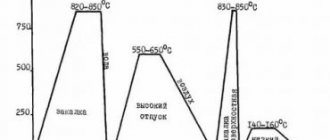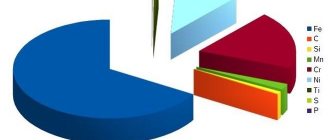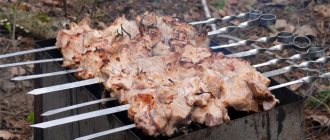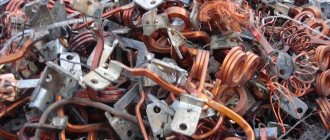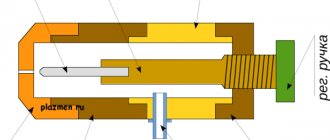Compound
Previously GOST 1050-88, and now GOST 1050-2013 regulates the production of steel 35. The document describes the chemical composition, mechanical properties, hardness, and processing methods. The number 35 is a decoding of the carbon content in steel, which is 0.35%.
Steel grade 35 has the composition:
- Iron ~97%
- Nickel ~0.25%
- Carbon - 0.32-0.40%
- Manganese - up to 0.5-0.8%
- Silicon - 0.17-0.37%
- Sulfur - up to 0.035%
- phosphorus - no more than 0.030%
- Chromium - no more than 0.25%
- Copper - no more than 0.25%
- Arsenic - up to 0.08%
The composition of the steel is “not rich”. There are no expensive and useful additives such as chromium and molybdenum. Such steel will have a low strength and hardness coefficient, and will be used for applications where the high strength of the raw material is not important.
All indicators of steel largely depend on the mass fraction of carbon. It can become brittle and dense, like cast iron. Or durable, mixed with other components, such as 10th grade. The dependence of the material parameters also depends on the amount of other impurities: manganese, nickel, chromium, silicon. Each of them increases some indicator, and in return carries a minus.
It is the combination of impurities that plays the main role in the characteristics of the metal. Expensive steel grades have high strength, weldability and corrosion resistance. Most often, the material is selected depending on the type of purpose: to create parts where strength is important, high-quality brands are selected, and for welding and the manufacture of electrodes, cheaper analogues are selected.
Application of steel 35
As previously noted, the metal in question is widely used. This is due to the low production cost and fairly high performance characteristics. The alloy is often used to produce the following parts:
- Characterized by low strength and experiencing low stress. This group includes crankshafts, axles, cylinders, rims, traverses and others.
- Various fasteners: bolts, nuts and studs. They are cheap, but cannot be used in the manufacture of wear-resistant parts.
When choosing this alloy, it should be taken into account that due to the fairly high carbon concentration, the degree of weldability is significantly reduced. Therefore, in most cases, workpieces are supplied for machining. Corrosion resistance is average; the resulting parts can be used in moderately aggressive environments. The resulting bolts are often used when constructing foundations or creating other load-bearing structures.
Analogs of steel 35 have similar chemical composition and properties, and are marked when applying GOST standards. Other countries have their own standards. For example, in the USA, analogues are called 1034, 1035; alloys ML35 and ZG270-500 are supplied from China. A more affordable offer is metals produced by domestic companies.
Analogs
- USA - 1034, 1035, 1038, G10340, G10350, G10380, G10400
- Germany - 1.0501, 1.1181, 1.1183, C35, C35E, C35R, C38D, Cf35, Ck35, Cm35, Cq35
- Japan - S35, S35C, S38C, SWRCH35K, SWRCH38K
Substitutes for steel grade 35 are: 30, 35G and 40. In their composition, the most significant difference is the mass fraction of carbon. Despite this, the properties of these brands have practically no characteristic differences between each other and are high-quality substitutes for each other.
Welding medium and high carbon steels
Medium carbon steel structures can be welded well if the welding rules and the following additional guidelines are strictly observed. In butt, corner and T-joints, when assembling the elements being connected, the gaps provided by GOST should be maintained between the edges so that welding transverse shrinkage occurs more freely and does not cause crystallization cracks. In addition, starting from a steel thickness of 5 mm or more, edges are cut in butt joints, and welding is carried out in several layers. The welding current is reduced.
Welding high carbon steel
Welding high-carbon steels of grades VSt6, 45, 50 and 60 and cast carbon steels with a carbon content of up to 0.7% is even more difficult. These steels are mainly used in castings and tool making. Their welding is possible only with preliminary and concomitant heating to a temperature of 350-400 ° C and subsequent heat treatment in heating furnaces. When welding, the rules for medium carbon steel must be followed; we will discuss this process below.
Welding technologies for high carbon steels
Good results are achieved when welding narrow beads and small areas with cooling of each layer. After welding is completed, heat treatment is required.
Welding medium carbon steel
Welding medium-carbon steel grades VSt5, 30, 35 and 40, containing carbon 0.28-0.37% and 0.27-0.45%, is more difficult, since the weldability of steel deteriorates with increasing carbon content.
Characteristics and properties
The strength of steel is low, but it is quite sufficient for many industrial purposes. Density is 7.826 g/cm. Density is necessarily taken into account in the fields of mechanical engineering, aircraft manufacturing, construction, shipbuilding and other industries.
The cutting ability of the material is good, so it is easier to process or give ultra-precise shapes to parts. The metal has limited weldability.
Despite its nickel content, 35 steel is susceptible to corrosion. This is due to the low content of ferromagnet.
The hardness is 163 MPa, which is quite high for such a low strength, but with effort, the metal can be slightly deformed on the machine.
Transportation and storage
All products are stored in moisture-protected warehouses on wooden pallets. For convenience, products of the same type are bundled and labeled. Supplied:
- sheets;
- rolls.
Sales and delivery to sites in the city and in the Moscow region using our own vehicles, delivery service to all regions of Russia - by rail. Pickup of goods from a warehouse in Domodedovo is possible.
To place an order online through the official website, contact a company consultant using the feedback form.
Application in various industries
Due to its resistance to impact loads, grade 35 steel can be used for the manufacture of fasteners: bolts, studs, nuts.
Since weldability is limited, this does not allow the grade to be widely used.
In mechanical engineering, metal is used only to create elements that do not suffer from wear.
In construction, grade 35 is used in the construction of water pipelines and the installation of reinforced concrete slabs. Plumbing products cannot do without 35 steel. Many factories use this steel and its analogues to produce enameled bathtubs and sinks, which are later used in construction.
Most of this steel grade is used for the production of rolled metal elements. Various steel mesh, sheets, corners and more. Often the 35th grade is used for the production of pipes of different diameters. This is due to the fact that steel “grabs” well when welded to any other pipe. Rods are often made from 35, which are then often used to create reinforced concrete slabs. Often the simplest metal parts are used for domestic purposes.
Steel 35 may not be the standard of quality and reliability, but it can be used in absolutely any industry. The popularity of this alloy is explained by its price; the metal is suitable for many purposes and does not have a high price.
Table 1. Mechanical properties of rolled products
| GOST | Forging condition | Section, mm | σв (MPa) | δ5 (δ4) % | ψ % | NV, no more |
| no less | ||||||
| 1050-88 | Hot-rolled, forged, calibrated and silver steel of the 2nd category after normalization | 25 | 530 | 20 | 45 | — |
| Calibrated steel, category 5: | ||||||
| after cold hardening | — | 590 | 6 | 35 | — | |
| after annealing or high tempering | — | 470 | 15 | 45 | — | |
| 10702-78 | Steel calibrated and calibrated with special finishing: | |||||
| after spheroidizing annealing | — | Up to 540 | — | 45 | 187 | |
| cold-worked without heat treatment | — | 590 | 5 | 40 | 207 | |
| 1577-93 | Annealed or high tempered sheets | 80 | 480 | 22 | — | — |
| Normalized or hot rolled strips | 6 — 25 | 530 | 20 | 45 | — | |
| 16523-70 (Transverse samples) | Hot rolled sheet | Up to 2 | 490 — 640 | -17 | — | — |
| Cold rolled sheet | 2 — 3,9 | 490 — 640 | -19 | — | — | |
| 4041-71(Transverse samples) | Heat-treated sheet of category 1-2 | 4 -14 | 480 — 630 | 22 | — | 163 |
| 2284-79 | Cold rolled strip: | |||||
| annealed | 0,1 — 4 | 400 — 350 | -16 | — | — | |
| cold-worked strength class H2 | 0,1 — 4 | 800 — 950 | — | — | — | |
| 8731-74 | Hot-, cold- and heat-deformed, heat-treated pipes | — | 510 | 17 | — | 187 |
| 8733-74 | ||||||
Table 2. Mechanical properties of forgings (GOST 8479-70)
| Type of heat treatment | Forging cross-section, mm | KP | σ0.2 (MPa) | σв (MPa) | δ5 (%) | ψ % | KCU (J/cm2) | NV, no more |
| Normalization | 300 — 500 | 195 | 195 | 390 | 20 | 45 | 49 | 111 — 156 |
| 500 — 800 | 18 | 38 | 44 | |||||
| 100 — 300 | 20 | 48 | 49 | |||||
| 300 — 500 | 215 | 215 | 215 | 18 | 40 | 44 | 123 — 167 | |
| 500 — 800 | 16 | 35 | 39 | |||||
| Normalization | Up to 100 | 245 | 245 | 470 | 2 | 48 | 49 | 143 — 179 |
| 100 — 300 | 19 | 42 | 39 | |||||
| 300 — 500 | 17 | 35 | 34 | |||||
| Hardening. Vacation | Up to 100 | 275 | 275 | 530 | 20 | 40 | 44 | 156 — 197 |
| 100 — 300 | 315 | 315 | 570 | 17 | 38 | 34 | ||
| Up to 100 | 17 | 38 | 39 | 167 — 207 |
Table 3. Mechanical properties at t = 20ºC
| Assortment | Size, mm | sв, MPa | sT, MPa | d5 | y, % | Heat treatment |
| % | ||||||
| Heat-treated sheet, GOST 4041-71 | 4 — 14 | 480 — 640 | 22 | |||
| Pipes, GOST 8731-87 | 510 | 294 | 17 | |||
| Calibrated rod, GOST 10702-78 | 590 | 45 | Annealing | |||
| Rolled products, GOST 1050-88 | up to 80 | 530 | 315 | 20 | 45 | Normalization |
| Cold-worked rolled products, GOST 1050-88 | 590 | 6 | 35 | |||
| Annealed rolled products, GOST 1050-88 | 470 | 15 | 45 | |||
| Annealed tape, GOST 2284-79 | 390 — 640 | 16 | ||||
| Cold-worked tape, GOST 2284-79 | 640 — 930 |
Table 4. Mechanical properties depending on tempering temperature
| Holiday temperature, C | σ 0.2 (MPa) | σв (MPa) | δ5 (%) | ψ % | KCU (J/cm2) | HB |
| Workpiece with a diameter of 60 mm, quenched at 850 °C in water | ||||||
| 200 | 600 | 760 | 13 | 60 | 29 | 226 |
| 300 | 560 | 735 | 14 | 63 | 29 | 212 |
| 400 | 520 | 690 | 15 | 64 | 98 | 200 |
| 500 | 470 | 660 | 17 | 67 | 137 | 189 |
| 600 | 410 | 620 | 18 | 71 | 176 | 175 |
| 700 | 340 | 580 | 19 | 73 | 186 | 16 |
Table 5. Fatigue limit of steel 35
| σ-1, MPA | J-1, MPA | Steel condition and heat treatment |
| 265 | — | Normalization 850 °C, σв=570 MPa |
| 245 | 147 | Normalization 850-890 °C. Holiday 650-680 °C |
| 402 | — | Hardening 850 °C. Vacation 650 °C, σв=710 MPa |
Table 6. Impact strength
| T= +20 C | T= -20 C | T= -30 C | T= -40 C | T= -60 C | Heat treatment |
| 63 | 47 | 45 | 14 | 12 | Normals |
Table 7. Technological characteristics
| Weldability: | limited weldability. |
| Flock Sensitivity: | not sensitive. |
| Tendency to temper brittleness: | not inclined. |
Table 8. Physical properties
| T (Grad) | E 10-5 (MPa) | a 10 6 (1/Deg) | l (W/(m deg)) | r (kg/m3) | C (J/(kg deg)) | R 10 9 (Ohm m) |
| 20 | 2,06 | 7826 | ||||
| 100 | 1,97 | 12 | 49 | 7804 | 469 | 251 |
| 200 | 1,87 | 12,9 | 49 | 7771 | 490 | 321 |
| 300 | 1,56 | 13,6 | 47 | 7737 | 511 | 408 |
| 400 | 1,68 | 14,2 | 44 | 7700 | 532 | 511 |
| 500 | 14,6 | 41 | 7662 | 553 | 629 | |
| 600 | 15 | 38 | 7623 | 578 | 759 | |
| 700 | 15,2 | 35 | 7583 | 611 | 922 | |
| 800 | 12,4 | 29 | 7600 | 708 | 1112 | |
| 900 | 13,9 | 28 | 7549 | 699 | 1156 |
Rate this article:
Rating: 0/5 — 0 votes
Structural carbon quality steel 35
Mark 35 – purpose
Structural high-quality carbon steel 35 is used for the manufacture of low-strength products that operate under low stress - cylinders, press columns, axles, crankshafts, earrings, spindles, connecting rods, sprockets, rims, rods, traverses, disks, bandages, and other parts.
Steel 35 - domestic analogues
| Rolled metal grade | Substitute |
| 35 | 30 |
| 40 | |
| 35g |
Characteristics
| Brand | GOST | Foreign analogues | Classification |
| 35 | 4041–71 | There is | Structural high-quality carbon steel |
| 8731–87 | |||
| 10702–78 | |||
| 1050–88 | |||
| 2284–79 |
Material 35 – technological features
Forging
| Type of semi-finished product | t, 0С | Cooling | |
| Section size | Conditions | ||
| mm | |||
| Ingot | 1280–750 | Forgings for critical purposes – all sizes | Normalization |
| Hypothermia | |||
| Hypothermia | |||
| Vacation | |||
| up to 400 | On air | ||
| 401–800 | Annealing | ||
| more than 800 | Low temperature annealing | ||
| Hypothermia | |||
| Blank | up to 800 | On air | |
Welding
| Weldability | Welding methods | Recommendations |
| limited | EHS, RDS, ADS (flux + shielding gas) | Heating + heat treatment |
| KTS | no restrictions |
Flock sensitivity
Not sensitive.
cutting
| Initial data | Machinability Ku | |||
| State | HB, MPa | sB, MPa | hard alloy | high speed steel |
| hot rolled | ≤ 187 | 510 | 1,26 | 1,2 |
Tendency to temper brittleness
Not inclined.
Brand 35 – chemical composition
Mass fraction of elements no more than, %:
| Silicon | Manganese | Copper | Arsenic | Nickel | Sulfur | Carbon | Phosphorus | Chromium |
| 0,17–0,37 | 0,5–0,8 | 0,3 | 0,08 | 0,3 | 0,04 | 0,32–0,4 | 0,035 | 0,25 |
Steel 35 – mechanical properties
| Assortment | GOST | Dimensions – thickness, diameter | Heat treatment | KCU | y | d5 | sT | sв |
| mm | kJ/m2 | % | % | MPa | MPa | |||
| Sheet | 4041–71 | 4–14 | 22 | 480–640 | ||||
| Pipes | 8731–87 | 17 | 294 | 510 | ||||
| The rod is calibrated. | 10702–78 | Annealing | 45 | 590 | ||||
| Rental | 1050–88 | up to 80 | Normalization | 45 | 20 | 315 | 530 | |
| hardened. | 35 | 6 | 590 | |||||
| annealed | 45 | 15 | 470 | |||||
| The tape is annealed. | 2284–79 | 16 | 390–640 | |||||
| hardened. | 640–930 |
Hardness, MPa
| Assortment | GOST | HB 10-1 |
| Sheet after heat treatment | 4041–71 | 163 |
| Pipes | 8731–87 | 187 |
| Rolled hot rolled products. | 1050–88 | 207 |
| calibrated hardened. | 229 | |
| calibrated annealed | 187 |
Alloy steel welding
Alloy steels are one of the most popular. Their main feature is their composition. Various alloying components are added to it, thanks to which the steel can be given the desired properties and characteristics. Simply put, due to alloying additives, it becomes possible to adjust the composition to your needs.
If necessary, such steel can be made stronger, more durable and better. You can literally change its physical and chemical properties by simply adding alloying elements to the composition.
A few more advantages of alloy steel: increased heat resistance, corrosion resistance (not at the level of stainless steel, of course, but still high resistance). To weld this type of steel, you can use arc welding and electrodes that contain fluorine and calcium. But we recommend gas welding. It is more complicated, but at the same time allows you to get better connection quality.
Gas welding technology, of course, differs from classic semi-automatic or inverter welding. Here the heat is generated not by the electric arc, but by the welding flame. It is formed when a flammable gas mixes with oxygen and burns. The technology of welding carbon steels using gas requires skill and experience. But that doesn't mean you can't experiment. Practice on a scrap piece of metal before doing the main work.
Welding structural steel
Structural steel is used much more often than tool steel. Everything is made from it: from small parts to factory machines. It is this category that includes welding of 40x steel, 30xgsa steel, 35xgsa steel and other other grades.
What is structural steel? This is a very interesting metal in composition. It consists of various impurities, in particular phosphorus and sulfur. The more of these components there are in the composition, the more unreliable the steel will be, so you need to monitor this indicator. Structural steel can be ordinary, high-quality, high-quality and especially high-quality.
As you understand, the latter type of structural steel contains a minimum of impurities, due to which it is possible to obtain truly high-quality and durable metal. Well, ordinary structural steel contains the most impurities; it is considered the most short-lived. By the way, this classification also has separate subgroups (they differ in the presence of some additional chemical components). But we will not describe the classification in detail so as not to confuse you.
Technology and features of steel welding
In modern industry, a wide variety of steel is used for welded structures. It can be stainless or ordinary, high or low carbon, heat resistant and so on. Various technologies are used for welding them, but the simplest is welding with a semi-automatic machine or inverter. In this article we will talk about the features of popular types of steel and how to weld them.
